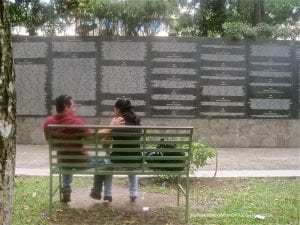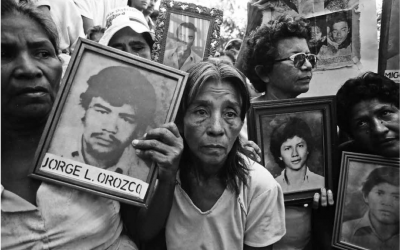Discovering Dominga
Adoptions and Tangled Truths
In the open central market one morning in Rabinal, Guatemala, 28-year-old Denese Becker picked up a bolt of corte cloth, woven fabric used by Achi Maya women to make their skirts, and brought it to her face. She closed her eyes. “My mother,” she said. “This smells like my mother.” I knew which one she was talking about.
That was more than a decade ago; we were in Rabinal to shoot the PBS documentary Discovering Dominga, the story of an Iowa housewife—Denese—a survivor of the 1982 Rio Negro massacre in which both her parents died. Denese, the former Dominga Sic, was returning to look for the bones of her father and to untangle the truth of a lifetime of nightmares. On that journey she also discovered a world of memory that might have remained hidden in small-town Iowa, where she arrived at age eleven, adopted by an evangelical pastor and his wife. Her adoptive parents were loving and attentive to her, their only daughter. However, as I watched Denese Becker in the Guatemala highlands, among trees and flowers once familiar to her, I couldn’t help thinking how much this young woman had lost by being taken from her roots to live in a strange land.
“What is this tree called?” she would ask. “I know you can eat its leaves.” Or, “I think I recognize that flower. It’s bad. Don’t touch it.”
Like Denese, thousands of children during the Central American conflict were adopted by foreigners, mostly from the United States and Europe. When my husband and I arrived in Tegucigalpa from San Francisco with our 8-month old in 1987, the hotel clerk glanced at the infant slung across my chest and said, “I assume you want the adopting parents’ rate.” During the week it took us to find a rental house, we learned that a dozen U.S. couples at the hotel, and several single individuals, had come to Honduras not to live, but to adopt.
When conflict, displacement and extreme poverty were national conditions in the 1980s and 1990s in Central America, “orphans” was a term used indiscriminately for youngsters separated from their families, whether they had a living parent or close relatives or not. Reasons were myriad: both parents might indeed be dead, killed in the violence, as in Denese’s case, although close relatives said later they had searched for her fruitlessly in Guatemala; soldiers and other armed authorities took children after families were killed; in many cases desperately poor single mothers, pregnant again, gave away newborns or sold them to enganchadores, front men for corrupt lawyers connected to ostensibly legitimate operations that can only be called “the baby trade.” In Honduras, and sometimes in Guatemala, newspapers periodically ran stories about the latest discovery of a casa cuna, houses where multiple infants were fattened up from low birth weights before presentation to prospective adoptive parents.
We will never know the true answer to the endless question, “Weren’t those children better off raised elsewhere?” We simply won’t know. What we can suggest in the wake of those terrible spasms of violence in Central America, at least, is that those of us who were meant to be watching events so closely did not track the region’s youngest and most vulnerable inhabitants to the degree they deserved.
Their stories are many. In 1980s El Salvador, for instance, a six-year old being adopted by a blind Italian man and his wife at our hotel approached me to say her mother sold grilled meat near the Parque Libertad. She wanted to return to her mother. Engaged with my own toddler, covering post-earthquake events daily, I never investigated, and the moment slipped away. At a holding camp for civilians “rescued” by the army from Guazapa, a rebel stronghold, an elderly woman said her grandson had been taken by an officer; she feared he would raise him as his own. In mountainous Las Vueltas, known as territory sympathetic to rebels, a man showed me where he had lain in tall grass as his seven-year old was taken away in a helicopter during an army sweep, while she cried out, “Papi!” He wept to recall he could not reach out to her without endangering others who hid around him.
“Do you think they will know that she is not an orphan?” he asked. “That I am her father and I am alive? Will she know that wherever she is?”
There are reasons why journalists, academic researchers and others do not investigate such stories at the time, including the urgency of other coverage and the general confusion of war. Some feel that any child removed from the risk of war or life of poverty is indeed better off, and questions ought to stop there for the good of all.
During the weeks we filmed Discovering Dominga in 2001 and 2002, Denese could not bring herself to accept invitations to sleep in the dirt-floor houses of her relatives; their lives and living conditions were too foreign to her. One day, we met an ajq’ij, a spiritual guide charged with giving thanks to the Creator lords, keeping the Maya calendar and performing ceremony. “What does his red kerchief mean?” she asked me later. “My grandfather wore one.” Now an evangelical Christian, she seemed to struggle with the knowledge that her grandfather had been a guardian of Maya spirituality, so inimical to the beliefs of her extended adoptive family. In the film Denese says that as a child in Iowa she never “fit in”; but off camera in Rabinal, it seemed clear that neither did Denese Becker/Dominga Sic “fit in” any longer among the people to whom she was born.
An advantage of peace is the gift of space and time to ask questions about what has come before. How much of the memory of the homelands is carried in the minds of children, now adults, as they live far from where they were born? Should adoptions during time of war be forbidden, or truncated in any way? They are questions we might consider before we are forced, should the occasion arise, to answer them again.
Mary Jo McConahay is the author of Maya Roads, One Woman’s Journey Among the People of the Rainforest (Chicago Review Press). She wrote the original story for the PBS documentary Discovering Dominga and co-produced it with producer Pat Flynn.
Related Articles
A Search for Justice
In 2004, when I left Harvard and last saw you, I thought I would never learn the truth of what exactly happened to Carlos Horacio in the horrendous holocaust of the Palace of Justice in Bogotá. Yet fate was holding a tremendous surprise for my daughters and me, filled with…
Memory: Editor’s Letter
Editor's Letter Memory Irma Flaquer’s image as a 22-year-old Guatemalan reporter stares from the pages of a 1960 Time magazine, her eyes blackened by a government mob that didn’t like her feisty stance. She never gave up, fighting with her pen against the long...
A Search for Justice in El Salvador: One Legacy of Ignacio Martín-Baró
In the small rural town of Arcatao, Chalatenango, Rosa Rivera clung to the hope that one day she would find the remains of her disappeared mother and father and lay them to rest in peace. Others sought to exhume mass graves hoping to recover bodies of nearly 1,000 relatives massacred in the Río Sumpul. …





